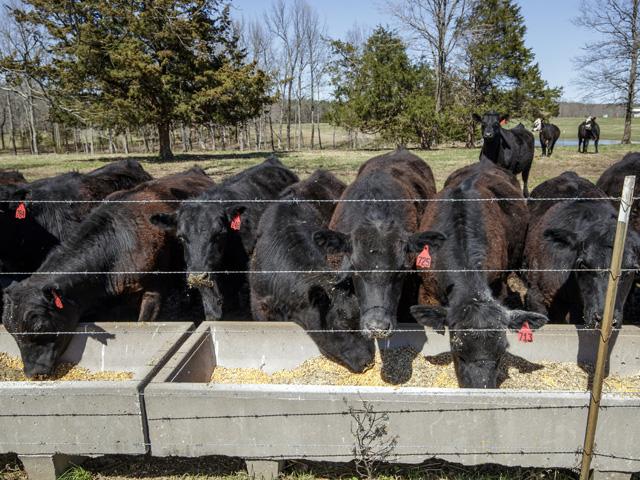Feeding Cow-Calf Pairs in Drought
Options on How to Feed Cow-Calf Pairs During Drought
OMAHA (DTN) -- While areas of North Dakota have seen some improvement in the drought that decimated the state in 2021, cow-calf producers need to be prepared for another drought this growing season.
Their plans should include knowing what feedstuffs can be used if drought limits pasture and rangeland grass production. Producers should consider several different drought management approaches to survive limited feed situations.
MIXED MANAGEMENT STRATEGY
In a North Dakota State University (NDSU) Extension drought webinar focused on feeding cattle during a drought, three NDSU Extension specialists discussed different methods cow-calf producers can adopt to assure their cattle get enough nutrients while also trying to manage increased costs. (See https://www.youtube.com/…)
Bryon Parman, NDSU Extension agricultural finance specialist, said feed costs are high but the good news is cattle prices are also on the high side. Hay prices essentially doubled from 2020 to 2021 and these prices continue to be elevated.
Cow-calf producers might want to consider using a mixed management strategy when it comes to feeding cow-calf pairs during drought, he said.
Parman said producers should focus on four aspects in the mixed management strategy.
The first phase is to use less pasture and rangeland grass.
The second strategy is to drylot some percentage of the cow herd and combine this with early weaning.
The third aspect of mixed management is to haul cattle to an area with less expensive feed costs.
And the fourth and final part of the mixed management strategy is to consider deep culling a portion of the herd.
"Studies show that this is the least-cost strategy of feeding cattle (during drought)," he said.
P[L1] D[0x0] M[300x250] OOP[F] ADUNIT[] T[]
TO FEED OR NOT TO FEED?
The first decision to make is whether you want to feed your cows or cull some of the herd, according to Zac Carlson, NDSU Extension beef cattle specialist.
Then, decide if you need to give cow-calf pairs some sort of supplemental feed while they are grazing or if you are going to do a drylot type of situation.
"Feed considerations in a drought is a big deal," Carlson said.
CALVING TIME MATTERS
Calving time will determine what kind of plan to implement in feeding cow-calf pairs, according to Karl Hopp, NDSU Extension livestock systems specialist.
Those that calve in January and February might be able to wean calves early, he said. This might even occur before the cows are turned out to grass and these calves can be fed in a drylot.
Cattle producers who calve in March and April might want to consider early weaning in July. Pairs could be fed in a drylot. then wean the calves and the cows could go to grass while the calves go to a lot. Supplemental feed could be fed while the cows are grazing, he said.
Hopp said those who calve in May and June would want to supplement their herd while they are grazing. If no grass is available, then feed in a drylot situation.
"These cattle are going to be heading towards their peak nutritional needs, so feed costs will be more," Hopp said.
SUPPLEMENTAL FEED NEEDS
Supplemental feeds have to provide the cattle with their energy and protein requirements, he said.
Corn is often the grain most associated with raising energy and protein needs, but there are other grains available that could do the same thing, Hopp said. North Dakota's variety of supplemental feeds include DDGs, field peas, lentils and different oilseed meals such as soybean, canola, sunflower and linseed.
Carlson said managing cattle in a drylot situation can be difficult as increased management is needed. Enough feed must be fed to maintain body condition score (BCS) and correct facilities are necessary.
An energy-dense, protein-adequate diet at more than 2% of body weight is needed. Keep in mind two- to three-month-old calves can consume 1% to 1.5% of their body weight, he said.
"Cows will need 2 feet of bunk space while 1 1/2 feet of bunk space is needed for calves," Carlson said.
Producers should use BCS to watch the condition of their cattle, he said. This should be monitored 90 days before calving, right at calving time and at the beginning of the breeding season.
Carlson said NDSU Extension specialists use the Beef Ration and Nutrition Decisions Software (BRaNDS) ration formulation program. Those with specific ration questions should contact their local NDSU Extension educator.
SAMPLE RATIOS
Hopp said NDSU Extension has sample ratios and calculated feed costs for the three different calving times. These costs were figured using the most recent cost of various feedstuffs, he explained. For January to February calving, a 1,350-lb. cow and 400-lb. calf were both on drylot ration. The cost for the cow came to $1.68/day and the calf was $1.46/day.
The total cost of feeding both the cow and the calf was $3.14/day, he said.
The same situation (cow and calf drylot) in the March-to-April calving scenario shows the feeding costs rise to $2.65/day and the May-to-June calving time jumps even more to $2.97/day.
Hopp said these numbers really help to show how much variation there can be in feed costs per day depending on when calving happens.
Russ Quinn can be reached at russ.quinn@dtn.com
Follow him on Twitter @RussQuinnDTN
(c) Copyright 2022 DTN, LLC. All rights reserved.




